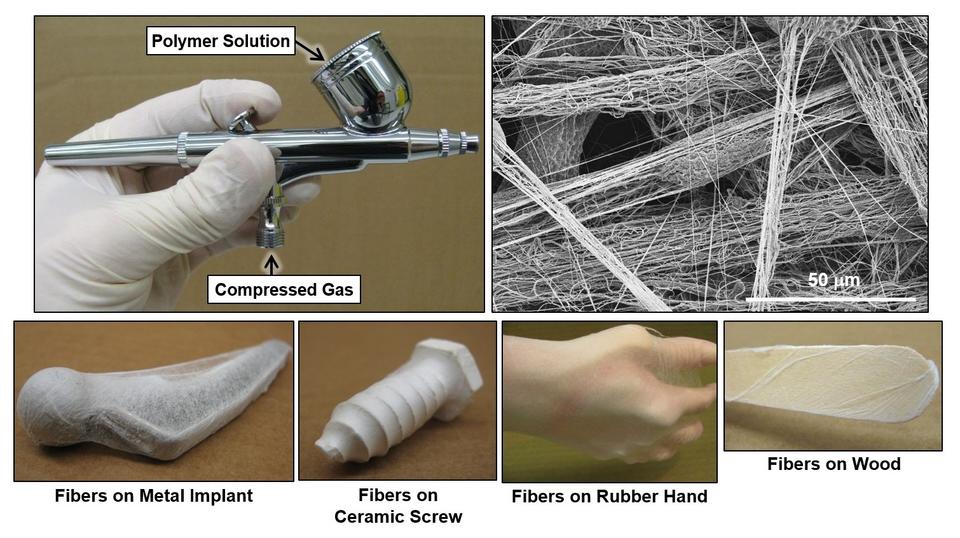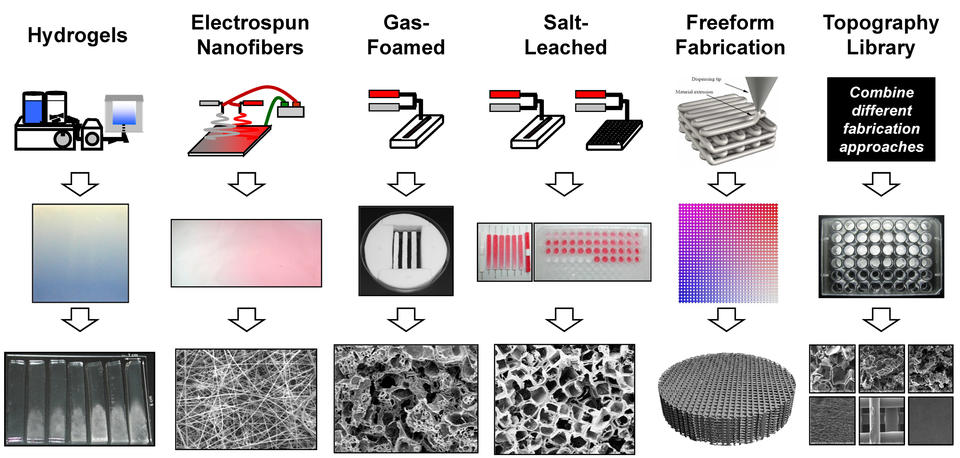Scaffold Fabrication: Airbrushed Scaffolds & Combinatorial Methods
Scaffold Fabrication: Airbrushed Scaffolds & Combinatorial Methods
Description: Polymeric nanofibers have shown great promise as a scaffold for tissue-engineering applications since they mimic the native nanofibrous structure of the extracellular matrix found in most soft tissues (collagen, fibrin, elastin). Electrospinning is a common approach for fabricating nanofiber scaffolds electrospinning, but it is slow and cannot be easily "aimed." Blowing polymer solution through an airbrush can produce nanofibers in a manner that is 10X faster than electrospinning. In addition, the airbrush may be aimed to deposit the fibers onto irregularly-shaped objects, which is a capability that may have potential for directed scaffold fabrication onto devices or wounds. This approach has been given a more effective name: pneumatospinning.
Publication: Tutak W, Sarkar S, Lin-Gibson S, Farooque TM, Jyotsnendu G, Wang D, Kohn J, Bolikal D, Simon Jr CG (2013) The Support of Bone Marrow Stromal Cell Differentiation by Airbrushed Nanofiber Scaffolds. Biomaterials 34, 2389-2398. https://doi.org/10.1016/j.biomaterials.2012.12.020

Protocol for Fabricating Salt-Leached or Gas-Foamed Scaffolds in Well-Plates:
3D Scaffold Libraries:
Combinatorial Screening: Cells respond differently to different materials. Chemistry, mechanics and structure of the materials have strong impact on whether cells adhere, proliferate, migrate or differentiate. We have developed a suite of combinatorial screening methods for 3D scaffolds. Previous combinatorial approaches for screening cell-material interactions have focused on planar (2D) surfaces or films. However, biomaterials are commonly used in 3D scaffolds and cells behave differently when cultured in a 3D environment. Thus, "combi" tests for many types of scaffolds and properties have been developed for a "scaffoldomics" approach.

Cell-Material Interactions: Combi-screens can provide "hits" that may be more rigorously explored. Our goal is to enable design of improved scaffolding materials by determining how 3D scaffold properties influence cell function. Much of our current knowledge of biomaterials is phenomenological. In order for tissue engineering to advance, a mechanistic understanding of how material properties direct stem cell function must be developed.
References for Scaffold Libraries:
Reviews on Scaffold Libraries
Simon Jr CG, Lin-Gibson S (2011) Combinatorial and high-throughput screening of biomaterials. Advanced Materials 23, 369-387.
Simon Jr CG, Yang Y, Thomas V, Dorsey SM, Morgan AW (2009) Cell interactions with biomaterials gradients and arrays. Combinatorial Chemistry and High-Throughput Screening 12, 544-553.
Libraries of Multiple Scaffold Types
Kumar G, Tison CK, Chatterjee K, Pine PS, McDaniel JH, Salit ML, Young MF, Simon Jr CG (2011) The determination of stem cell fate by 3D scaffold structures through the control of cell shape. Biomaterials 32, 9188-9196.
Gas-Foamed Scaffold Libraries
Chatterjee K, Kraigsley AM, Bolikal D, Kohn J, Simon Jr CG. (2012) Gas-foamed scaffold gradients for combinatorial screening in 3D. Journal of Functional Biomaterials 3, 173-182.
Nanofiber Scaffold Libraries
Ramalingam M, Young MF, Thomas V, Sun L, Chow LC, Tison CK, Chatterjee K, Miles WC, Simon Jr CG (2013) Nanofiber scaffold gradients for interfacial tissue engineering. Journal of Biomaterials Applications 27, 695-705.
Hydrogel Scaffold Libraries
Chatterjee K, Young MF, Simon Jr CG (2011) Fabricating gradient hydrogel scaffolds for 3D cell culture. Combinatorial Chemistry and High-Throughput Screening 14, 227-236.
Chatterjee K, Lin-Gibson S, Wallace WE, Parekh SH, Lee YJ, Cicerone MT, Young MF, Simon Jr CG (2010) The effect of 3D hydrogel scaffold modulus on osteoblast differentiation and mineralization revealed by combinatorial screening. Biomaterials 31, 5051-5062.
Salt-Leached Scaffold Libraries
Chatterjee K, Sun L, Chow LC, Young MF, Simon Jr CG (2011) Combinatorial screening of osteoblast response to 3D calcium phosphate/poly(e-caprolactone) scaffolds using gradients and arrays. Biomaterials 32, 1361-1369.
Simon Jr CG, Yang Y, Dorsey SM, Ramalingam M, Chatterjee K (2010) 3D polymer scaffold arrays. Methods in Molecular Biology: Biological Microarrays 671, 161-174.
Yang Y, Becker ML, Bolikal D, Kohn J, Zeiger DN, Simon Jr CG (2008) Combinatorial polymer scaffold libraries for screening cell-biomaterial interactions in 3D. Advanced Materials 20, 2037-2043.
Yang Y, Dorsey SM, Becker ML, Lin-Gibson S, Schumacher GE, Flaim GM, Kohn J, Simon Jr CG (2008) X-ray imaging optimization of 3D tissue engineering scaffolds via combinatorial fabrication methods. Biomaterials 29, 1901-1911.
Simon Jr CG, Stephens JS, Dorsey SM, Becker ML (2007) Fabrication of combinatorial polymer scaffold libraries. Review of Scientific Instruments 78, 0722071-0722077.
Contact: mmlinfo [at] nist.gov (mmlinfo[at]nist[dot]gov)
Contributors: Carl Simon

